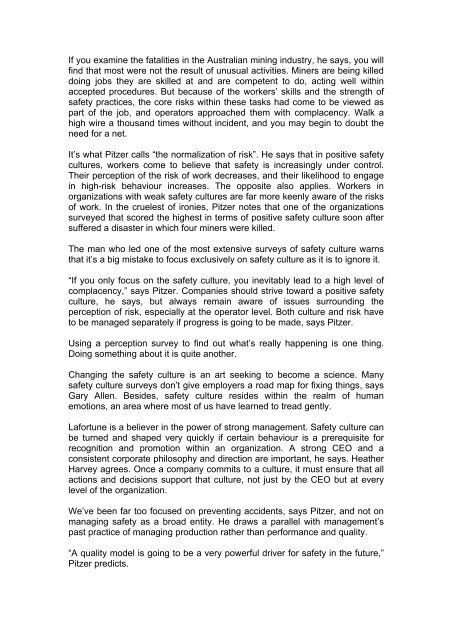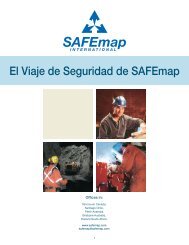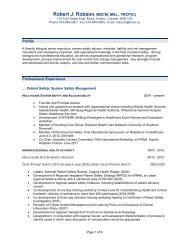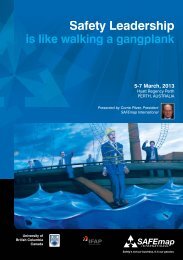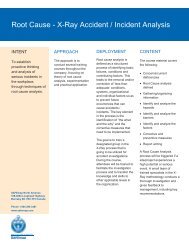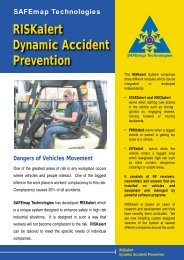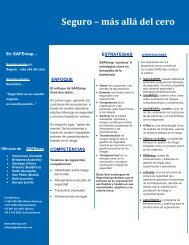A Matter of Perception - SAFEmap International
A Matter of Perception - SAFEmap International
A Matter of Perception - SAFEmap International
You also want an ePaper? Increase the reach of your titles
YUMPU automatically turns print PDFs into web optimized ePapers that Google loves.
If you examine the fatalities in the Australian mining industry, he says, you willfind that most were not the result <strong>of</strong> unusual activities. Miners are being killeddoing jobs they are skilled at and are competent to do, acting well withinaccepted procedures. But because <strong>of</strong> the workers’ skills and the strength <strong>of</strong>safety practices, the core risks within these tasks had come to be viewed aspart <strong>of</strong> the job, and operators approached them with complacency. Walk ahigh wire a thousand times without incident, and you may begin to doubt theneed for a net.It’s what Pitzer calls “the normalization <strong>of</strong> risk”. He says that in positive safetycultures, workers come to believe that safety is increasingly under control.Their perception <strong>of</strong> the risk <strong>of</strong> work decreases, and their likelihood to engagein high-risk behaviour increases. The opposite also applies. Workers inorganizations with weak safety cultures are far more keenly aware <strong>of</strong> the risks<strong>of</strong> work. In the cruelest <strong>of</strong> ironies, Pitzer notes that one <strong>of</strong> the organizationssurveyed that scored the highest in terms <strong>of</strong> positive safety culture soon aftersuffered a disaster in which four miners were killed.The man who led one <strong>of</strong> the most extensive surveys <strong>of</strong> safety culture warnsthat it’s a big mistake to focus exclusively on safety culture as it is to ignore it.“If you only focus on the safety culture, you inevitably lead to a high level <strong>of</strong>complacency,” says Pitzer. Companies should strive toward a positive safetyculture, he says, but always remain aware <strong>of</strong> issues surrounding theperception <strong>of</strong> risk, especially at the operator level. Both culture and risk haveto be managed separately if progress is going to be made, says Pitzer.Using a perception survey to find out what’s really happening is one thing.Doing something about it is quite another.Changing the safety culture is an art seeking to become a science. Manysafety culture surveys don’t give employers a road map for fixing things, saysGary Allen. Besides, safety culture resides within the realm <strong>of</strong> humanemotions, an area where most <strong>of</strong> us have learned to tread gently.Lafortune is a believer in the power <strong>of</strong> strong management. Safety culture canbe turned and shaped very quickly if certain behaviour is a prerequisite forrecognition and promotion within an organization. A strong CEO and aconsistent corporate philosophy and direction are important, he says. HeatherHarvey agrees. Once a company commits to a culture, it must ensure that allactions and decisions support that culture, not just by the CEO but at everylevel <strong>of</strong> the organization.We’ve been far too focused on preventing accidents, says Pitzer, and not onmanaging safety as a broad entity. He draws a parallel with management’spast practice <strong>of</strong> managing production rather than performance and quality.“A quality model is going to be a very powerful driver for safety in the future,”Pitzer predicts.


